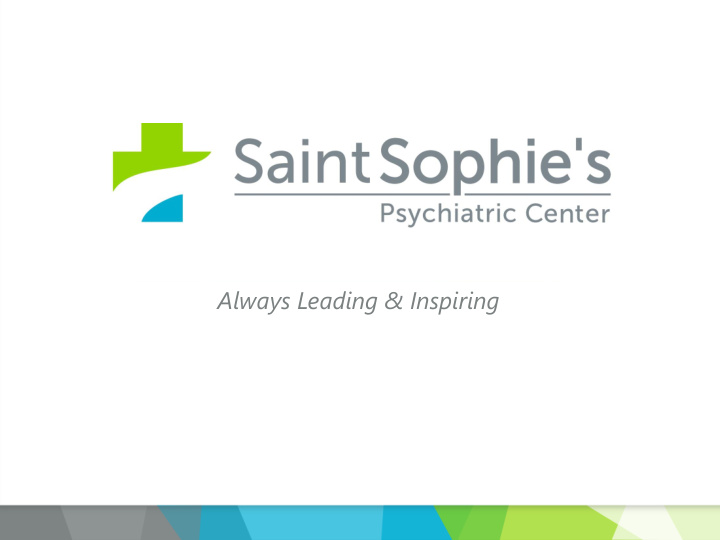



Always Leading & Inspiring
Pediatric Case Study Connie Soper, PA-C, MSPAS
Presentation: • Patient present with parents • Parents have complaints of behavior problems.
Symptoms • Parents report: – Problems in school in areas of academics and behavior. – Problems at home with parents and siblings. – Problems with peers at school and in the neighborhood.
Patient History • No family history of mental health problems • Attends private school • Poor performance in 1 st grade • Has trouble sleeping, has nightmares • No known history of trauma
• Lives with biological parents and 2 siblings • Two older siblings w/o behavior or emotional problems
DMDD DSM-5 Criteria *Severe recurrent temper outbursts *Temper outbursts inconsistent with developmental level. *Temper outbursts 3x week average *Mood is persistently irritable or angry most of the day *Above criteria present for at least 12 months
*Not a period of 3 months without symptoms *Symptoms present in at least 2 of 3 settings (home, school, peers) *Dx not made before age 6 or after age 18 *Criteria met before age 10 *No periods of mania or hypomania greater than one day.
*Behaviors do not occur exclusively during an episode of MDD and are not better explained by another mental disorder *Symptoms not attributable to the physiological effects of a substance or to another medical or neurological condition.
DMDD Criteria met
DMDD • DSM-5 published in 2013 – Controversial diagnosis • Some feel that it should be a modifier of ADHD or Childhood Bipolar disorder rather than it’s own entity. • Emotional dysregulation was part of ADHD criteria until 1980 when it was determined to not be part of the diagnosis.
DMDD vs. Bipolar Disorder in children DSM-5 included DMDD episodic nature of irritability in bipolar disorder and chronic severe non-episodic irritability in DMDD is the primary distinction.
ADHD Persistent pattern of inattentive and or hyperactive/ impulsive behavior that interferes with functioning or development.
• Prevalence in the US overall: 10.2 percent of children age 4-17. (2015-2016) • More boys (14%) than girls (6.3%) • 5.4 million children with a current diagnosis of ADHD • 2/3 are taking medication as part of their treatment
• Interesting fact… • A population based study using DSM-IV criteria showed 15.5% of children grades 1-5 met criteria for ADHD. • Study used rating scales filled out by teachers and telephone interviews of parents of 7,847 children.
Inattentive criteria (6) *Fails to give close attention to details/careless mistakes *Difficulty sustaining attention in tasks or play *Does not seem to listen *Does not follow through on instructions • Has difficulty organizing tasks
*Avoids, dislikes or is reluctant to engage in tasks that require sustained mental effort *Looses things *Easily distracted • Forgetful in daily activities
Inattentive Criteria met
Hyperactive Criteria (6) *Often fidgets or taps hands or feet *Leaves seat in situations when remaining seated is expected *Unable to Play or engage in leisure activities quietly *Often on the go *Talks excessively *Blurts out answers
*Difficulty waiting his/her turn *Interrupts or intrudes on others
Hyperactivity Criteria met
GAD • DSM-5 criteria – Excessive worry at least 6 months – Difficult to control the worry – Anxiety and worry associated with (3) • Restlessness/ keyed up or on edge • Easily fatigued • Difficulty concentrating/ mind going blank • Irritability / Muscle tension • Sleep disturbance
• Causes clinically significant distress, impairment of social, occupational or other important areas of functioning. • Not secondary to substance use • Not better explained by another mental disorder
GAD *Excessive worry *Nightmares *Fear of dying *Sleep disturbance *Tachycardia *Feeling of butterflies in her stomach
• Symptoms meet criteria for • Disruptive Mood Dysregulation Disorder • Attention Deficit Hyperactivity Disorder • Generalized Anxiety Disorder
Reasons to treat • Impairs quality of life • Impairs active learning and school performance for the child • Negatively affects relationships with family members • Difficult to make/maintain friendships
Treatments • Therapy – Learn to regulate behavior – Learn strategies including mindfulness and distress tolerance – Parent training- they can learn to avoid reinforcing undesirable behavior and to reinforce desired behaviors when they occur.
• Multiple programs for parent interaction training • Similar principles including: – Consistent rules that are clearly defined – Reinforcement of desirable behaviors – Consistent consequences for noncompliance
• Nurtured Heart Approach: – A program designed for parent education regarding children diagnosed with a variety of behavioral, emotional and anxiety related problems. – Uses solid principles – Available in many formats online, workshops and textbook/ workbooks
Pharmacologic • Medications – Stimulants – Antidepressants (SSRIs, SNRIs) – Second Generation Antipsychotics (risperidone, aripiprazole)
• Stimulant can help control aggression • If no improvement with stimulants and therapy then antipsychotics considered.
Course of treatment • Visit 1 – Started SSRI for anxiety and irritability – Mild response, adjusted dose • Visit 3 – School principal- last chance – Parents consented to trial of stimulant medication – Significant improvement, adjust dose
– Dismissed from private school, parent recalls that stimulant medication was forgotten one day leading to her dismissal. – Doing well in public school Eventually …. – Not sleeping well – Worsening behavior lying and aggression
• Inappropriate at school raising her middle finger to teachers and other adults. • More lying • More aggression leads to max dose of methylphenidate • Discussion of Second Generation Antipsychotic if symptoms continue
• Behavior improves temporarily with increased dose of stimulant • Parents consent to SGA • Low dose aripiprazole is started.
• She tolerates it well. • No recent aggression • Parents have no complaints. • School has no complaints. • Life. Is. Good.
Recommend
More recommend